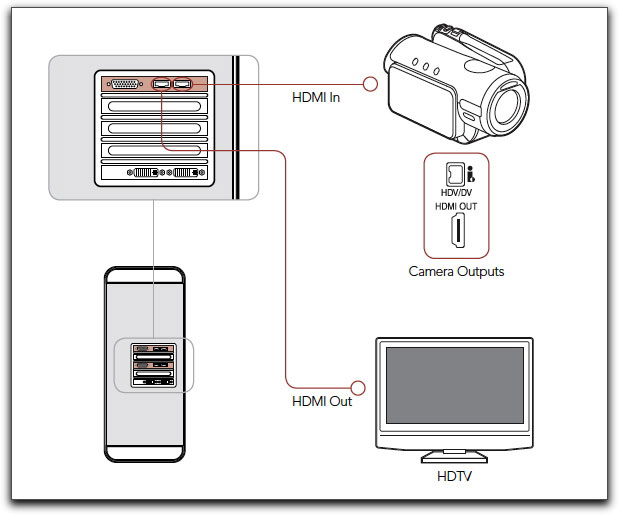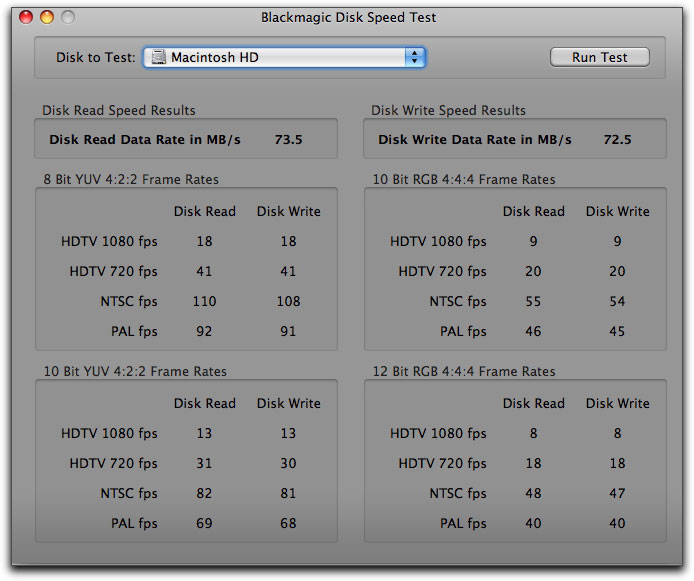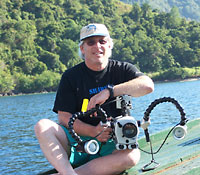| Review: Blackmagic
Design Intensity Pro |
Febuary, 2009

Blackmagic
Design Intensity Pro
www.blackmagic-design.com
$349.00
Review by Steve
Douglas
As
the technology of video grows and provides an ever more improved
image, the need to monitor that image for accurate color correction
and composite appearance becomes ever more important. Thus, the
videographer must make use of a high-resolution monitor enabling
him/her to truly see the details of the clip and the image consistency
throughout their sequence. The differences between what one sees
in the canvas of their NLE and what is displayed on a good external
monitor can be extremely significant.
The difficulty which presents itself
to many editors who do not work in deep pockets production houses,
is that in order to avoid the sole use of their canvas for image
adjustments, they must consider the costs of a good HDMI monitor
as well as an In/Out device that will enable them to view their
footage in the same detail and color space as their clients will
see upon receiving a finished product.
Fortunately, even in our current
debacle of an economy, the cost of good HDMI monitors has dropped
significantly over the last few years. On the In/Out device end
of things Blackmagic Design has produced a very affordable device
that, for many, will do the trick.

Blackmagic Design has brought out two
separate devices, the Intensity, selling as an HDMI only device
at $249.00, and the Intensity Pro. While I have only worked with
the Intensity Pro, basically the 2 devices are the same with
the Intensity Pro adding analog video and audio input and output
as well as analog component switches between high definition
and standard definition.


Produced to function only with Intel
Macs, the Intensity Pro's HD provides support for 1080i/50, 1080i
59.94, 720p50 and 720p 59.94 and provides Standard Definition
support for both NTSC and PAL. This leaves out the many who currently
shoot in 24p, and for those shooting in that format, the Intensity
Pro would not be for you in terms of capturing. However, you
are able to play it back over 59.94 if the clip has been captured
via firewire (HDV) or AVCHD. The reason for the 59.94 frame rate
is due to compatibility for televisions which may or may not
support it. In addition, while there are settings for Pro Res
422 HQ, I cannot understand why straight Pro Res 422 is not provided.
Never the less, there are many editors
who might not need 24p support, or use Pro Res, and the Intensity
Pro might do nicely within the editing bay for those without
these needs.

Most of the settings
you might wish you utilize are available whether you are shooting
in NTSC or PAL.
Installation of the Intensity Pro was simple. Anytime you install
hardware into the Mac you should first shut it down and remove
the power plug from you AC outlet. Upon removing the side cover
of the Mac Pro it was only a matter of locating a spare PCI Express
slot within the computer. The Intensity Pro PCI express card
inserted with a slight click and was firmly in place. Once installed
you can choose to connect your HDMI output of your camcorder
or deck to the HDMI Video input and then connect the HDMI output
to your monitor, or, if your camcorder or deck does not come
with an HDMI out, the Intensity Pro does provide component cables
for you to use as well.

Setup went smoothly, if your camcorder has an HDMI out, you can log and transfer/capture directly through the Intensity Pro. Another option would be to use the component in cables but I would hesitate to do that for fear of degradation of the signal.
Next you must download the software from the supplied disc and
install the latest drivers from the Blackmagic Design website.
The software disc provides an 'Uninstall Intensity' option if
that should ever become necessary. This is a something more companies
should provide and many don't. There are those who mistakenly
think that dragging an application to the trash will perform
a complete uninstall. Often this is not so, as frequently, many
support files are created that may be difficult to locate. Unfortunately,
I did not see a 'check for updates' anywhere in the Intensity
Pro settings, so that responsibility to check on their website,
now and then, will be up to you. When contacted regarding this,
I was told that they do intend to provide an option on the registration
page of their website to be notified as new drivers become available.
This shows an obvious and proactive concern for the Blackmagic
Design customer, and I would hope this would be incorporated
soon. For those who already have the Intensity or Intensity Pro
card, I am unsure how this would be handled retroactively, assuming
that you have already registered your card.
The Intensity Pro will work in Windows
XP and with Adobe Premiere Pro and Photoshop though I did not
test with either. Apple Final Cut Pro and the Intensity Pro does
allow you to work in most video standards from DV up to uncompressed
4:2:2 high definition video. Once installed the 'Easy Setups'
will have been automatically added. If you do not already have
Final Cut Studio installed, it is important that FC be installed
prior to the Intensity Pro.
As expected, the Blackmagic Designs'
Intensity Pro produced a beautiful image on the 32" Sony
Bravia HDMI monitor straight from Final Cut Pro's timeline or
from Adobe After Effects. How good that image will appear may
also depend upon the format that you are shooting in. Using DVC
Pro HD 720p 60 clips showed off not only the quality of clip
but the Intensity Pros' ability to output to broadcast standards
which rewarded me with rich colors and sharp detail. Using footage
that had been converted from 1440x1080i to Pro Res 422 also looked
good when playing. However, once I stopped on a frame, a good
deal of image noise appeared coupled with several interlacing
artifacts. This is probably due to the interlaced frames of the
original clip. Color correction could still be done with accurate
results. I did notice that when applying the 3-way color correction
filter to a clip, and then double clicking on the clip in the
timeline, that parameter adjustments would not always instantly
take place. Then I would double click on the clip again, go to
the filter and then all adjustments would immediately show on
the HDMI monitor. I have noticed this same procedure with other
I/O devices. Not sure why this happens, its as if there is a
lag time probably having to do with the HDMI output.
Since they do not provide any form of
device control, for those using AVCHD cameras, you would choose
your File>Log & Capture and do a Capture Now in the Log
and Capture window. For those using controllable camcorders or
decks device control is provided by Final Cut Pro and is independent
of Intensity. Blackmagic Design provides no support for device
control problems in conjunction with Intensity cards. This is
because HDMI does not provide for it. I would have liked to have
seen a firewire input on the Intensity Pro card to allow for
deck support as well as that there are still a great many consumer
cams that would make use of this method of ingestion.
For those wanting to check your disk
array, a stand alone application is installed called 'Blackmagic
Disk Speed Test'. This will provide you with, what may be important,
information regarding how your disk array will handle video capture
and playback at various video resolutions and frame rates. Just
locate the hard drive you want tested and click to start. It
took a very short time to get results.

Just for kicks I
ran the Blackmagic Disk Speed Test on the boot drive of my Dual
Core Mac Pro.
The bottom line with for the Blackmagic
Design Intensity Pro card is that it affords what, for many,
has been an unaffordable device to enable true monitoring of
your editing sequence. The quality of your output will often
depend upon the quality of the footage you have shot. It is a
shame, however, that with so many shooting in 24p, that this
option is not going to do the trick for them. However, a good
number of settings are available and the Intensity Pro comes
at an excellent price.
I would like to thank Royce Hildreth
of Hildreth Media for his expertise and assistance in this review.
 Steve
Douglas is a certified Apple Pro for Final Cut Pro 6 and underwater
videographer. A winner of the 1999 Pacific Coast Underwater Film
Competition, 2003 IVIE competition, 2004 Los Angeles Underwater
Photographic competition, and the prestigious 2005 International
Beneath the Sea Film Competition, where he also won the Stan
Waterman Award for Excellence in Underwater Videography and 'Diver
of the Year', Steve was a safety diver on the feature film "The
Deep Blue Sea", contributed footage to the Seaworld Park's
Atlantis production, and productions for National Geographic
and the History channels. Steve is also feature writer for Asian
Diver Magazine and is one of the founding organizers of the San
Diego UnderSea Film Exhibition. He is available for both private
and group seminars for Final Cut Pro and leads both underwater
filming expeditions and African safaris with upcoming excursions
to Kenya in Aug.09, the Red Sea and Egypt for Nov.2009, Truk
Lagoon and Yap in Micronesia for July, 2010. Feel free to contact
him if you are interested in joining Steve on any of these exciting
trips. www.worldfilmsandtravel.com
Steve
Douglas is a certified Apple Pro for Final Cut Pro 6 and underwater
videographer. A winner of the 1999 Pacific Coast Underwater Film
Competition, 2003 IVIE competition, 2004 Los Angeles Underwater
Photographic competition, and the prestigious 2005 International
Beneath the Sea Film Competition, where he also won the Stan
Waterman Award for Excellence in Underwater Videography and 'Diver
of the Year', Steve was a safety diver on the feature film "The
Deep Blue Sea", contributed footage to the Seaworld Park's
Atlantis production, and productions for National Geographic
and the History channels. Steve is also feature writer for Asian
Diver Magazine and is one of the founding organizers of the San
Diego UnderSea Film Exhibition. He is available for both private
and group seminars for Final Cut Pro and leads both underwater
filming expeditions and African safaris with upcoming excursions
to Kenya in Aug.09, the Red Sea and Egypt for Nov.2009, Truk
Lagoon and Yap in Micronesia for July, 2010. Feel free to contact
him if you are interested in joining Steve on any of these exciting
trips. www.worldfilmsandtravel.com
copyright © Steve
Douglas 2009
This article first appeared on www.kenstone.net
and is reprinted here with permission.
All screen captures and textual references are the property and
trademark of their creators/owners/publishers.